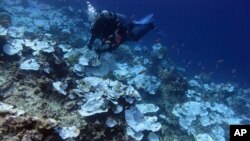ການສຶກສາໃໝ່ຂອງສະຫະປະຊາຊາດ ສະແດງໃຫ້ເຫັນວ່າ ຈຳນວນສັດ ແລະພືດ
ຕ່າງໆກຳລັງຫລຸດລົງ ຢູ່ໃນທຸກໆເຂດ ຂອງໂລກ.
ບັນດານັກວິທະຍາສາດ ທີ່ປະຊຸມກັນໃນວັນສຸກວານນີ້ ຢູ່ປະເທດໂຄລອມເບຍ ໄດ້
ອອກລາຍງານກ່ຽວກັບສະພາບຂອງຊີວະນາໆພັນຢູ່ໃນສີ່ຂົງເຂດຂອງໂລກ ຄືອາເມ
ຣິກາ ຢູໂຣບກັບເອເຊຍກາງ ອາຟຣິກາ ແລະເອເຊຍປາຊິຟິກ ແລະໄດ້ພົບເຫັນວ່າ ຢູ່
ໃນເຂດທັງໝົດນີ້ ພວກພືດແລະສັດຕ່າງໆ ກຳລັງຫລຸດລົງໃນອັດຕາທີ່ສູງ.
ພວກນັກວິທະຍາສາດເກືອບ 600 ຄົນໄດ້ພົວພັນ ໃນການເກັບກຳລາຍງານດັ່ງກ່າວ
ເປັນເວລາສີ່ປີ.
ອົງການ IPBES ຊຶ່ງເປັນອົງການຈັດຕັ້ງລະຫວ່າງລັດຖະບານ ກ່ຽວກັບນະໂຍບາຍ
ວິທະຍາສາດ ໃນດ້ານບໍລິການຊີວະນາໆພັນແລະລະບົບນິເວດ ໄດ້ເຕືອນວ່າ “ທ່າ
ອຽງ ທີ່ໜ້າຕື່ນຕົກໃຈນີ້ ແມ່ນເປັນອັນຕະລາຍຕໍ່ເສດຖະກິດ ຊີວິດການເປັນຢູ່ ຄວາມ
ປອດໄພດ້ານອາຫານ ແລະຄຸນນະພາບຂອງຊີວິດ ຂອງຜູ້ຄົນໃນ ທຸກຫົນທຸກແຫ່ງ.”
ປະທານອົງການ IPBES ທ່ານໂຣເບີດ ວັດສັນ ກ່າວວ່າ ການສູນເສຍຊີວະນາໆພັນ ແມ່ນມີຜົນກະທົບໂດຍກົງ ຕໍ່ມະນຸດ ຜູ້ທີ່ກາງຕໍ່ຊີວະນາໆພັນ ເພື່ອນຳມາໃຊ້ເປັນອາ
ຫານ ນໍ້າສະອາດ ແລະສາທາລະນະສຸກ.
ທ່ານວັດສັນ ໄດ້ກ່າວກ່ຽວກັບການພົບເຫັນວ່າ “ພວກເຮົາກຳລັງບ່ອນທຳລາຍຄວາມ
ຢູ່ເຢັນເປັນສຸກຂອງພວກເຮົາໃນອະນາຄົດ.”
ທ່ານກ່າວວ່າການສູນເສຍຊີວິດຂອງສັດ ແລະພືດ ເປັນຜົນມາຈາກຄວາມອຸດົມຮັ່ງ
ມີຕື່ມຂຶ້ນ ແລະມີຜູ້ຄົນແອອັດເພີ້ມຂຶ້ນໃນໂລກ ພ້ອມກັບຄົນທີ່ຕ້ອງການອາ ຫານເພີ້ມ
ຂຶ້ນ ຕ້ອງການນໍ້າສະອາດຫຼາຍຂຶ້ນ ພະລັງງານຫຼາຍຂຶ້ນ ແລະເນື້ອທີ່ຫຼາຍຂຶ້ນ.
ລາຍງານການພົບເຫັນດັ່ງກ່າວ ທໍານາຍວ່າ ພາຍໃນປີ 2050 ທະວີບອາເມຣິກາ ຈະມີ ພືດຕ່າງໆຫລຸດລົງ 40 ເປີເຊັນແລະພວກສັດຕ່າງໆໜ້ອຍກວ່າຕົ້ນຊຸມປີ 1700. ເກືອບ
ນຶ່ງສ່ວນສີ່ຂອງສາຍພັນທີ່ໄດ້ມີການຊັ່ງຊາຢ່າງເຕັມທີ່ນັ້ນເວລານີ້ແມ່ນພວມໄດ້ຮັບການ
ຂົ່ມຂູ່ຢູ່ໃນຂົງເຂດ ອີງຕາມການສຶກສາຄົ້ນຄວ້າ.
ຢູ່ໃນຂົງເຂດເອເຊຍປາຊິຟິກນັ້ນ ແມ່ນເກືອບ 90 ເປີເຊັນ ຂອງຫີນປະກາລັງຈະໄດ້ຮັບ
ຄວາມເສຍຫາຍ “ຢ່າງຮ້າຍແຮງ” ພາຍໃນໃນປີ 2050 ແລະຈຳນວນປາ ສໍາລັບການ
ຄ້າຫາປາ ມີການທຳນາຍວ່າ ຈະໝົດລົງພາຍໃນປີ 2048.
A new United Nations study shows the amount of animals and plants are on the decline in all areas of the world.
Scientists meeting Friday in Colombia issued reports on the state of biodiversity for four regions — the Americas, Europe and Central Asia, Africa, and Asia-Pacific — and found that in all these areas, plants and animals are declining at a high rate.
Nearly 600 scientists were involved in compiling the reports over three years.
"This alarming trend endangers economies, livelihoods, food security and the quality of life of people everywhere," warned the Intergovernmental Science-Policy Platform on Biodiversity and Ecosystem Services (IPBES).
IPBES chairman Robert Watson said the loss of biodiversity directly affects humans who rely on it for food, clean water and public health.
"We're undermining our own future well-being," Watson said of the findings.
He said the loss of animal and plant life is a result of the world getting wealthier and more crowded with people who need more food, more clean water, more energy and more land.
The report's findings predict that by 2050 the Americas will have 40 percent fewer plants and animals than in the early 1700s. Nearly a quarter of the species that were fully measured are now threatened in the region, according to the study.
In the Asia-Pacific region, up to 90 percent of corals will suffer "severe degradation" by 2050 and fish stocks for commercial fishing are predicted to run out by 2048.
In Africa, more than half of the continent's bird and mammal species are predicted to be lost by 2100 unless drastic measures are taken.
The report found that Europe and Central Asia is the region doing the best at preserving biodiversity. However, scientists said 28 percent of species that live only in Europe are now threatened.
The findings come during the same week that another species became closer to extinction following the death of the world's last northern white rhino male in Africa.
The report recommends that governments and businesses consider the impact on biodiversity when making decisions for development. It says that possible solutions to the decreasing biodiversity include creating more protected areas, restoring degraded zones, and rethinking subsidies that promote unsustainable agriculture.
"It's not too late" to stop or even reverse some of the harm, Watson said.





